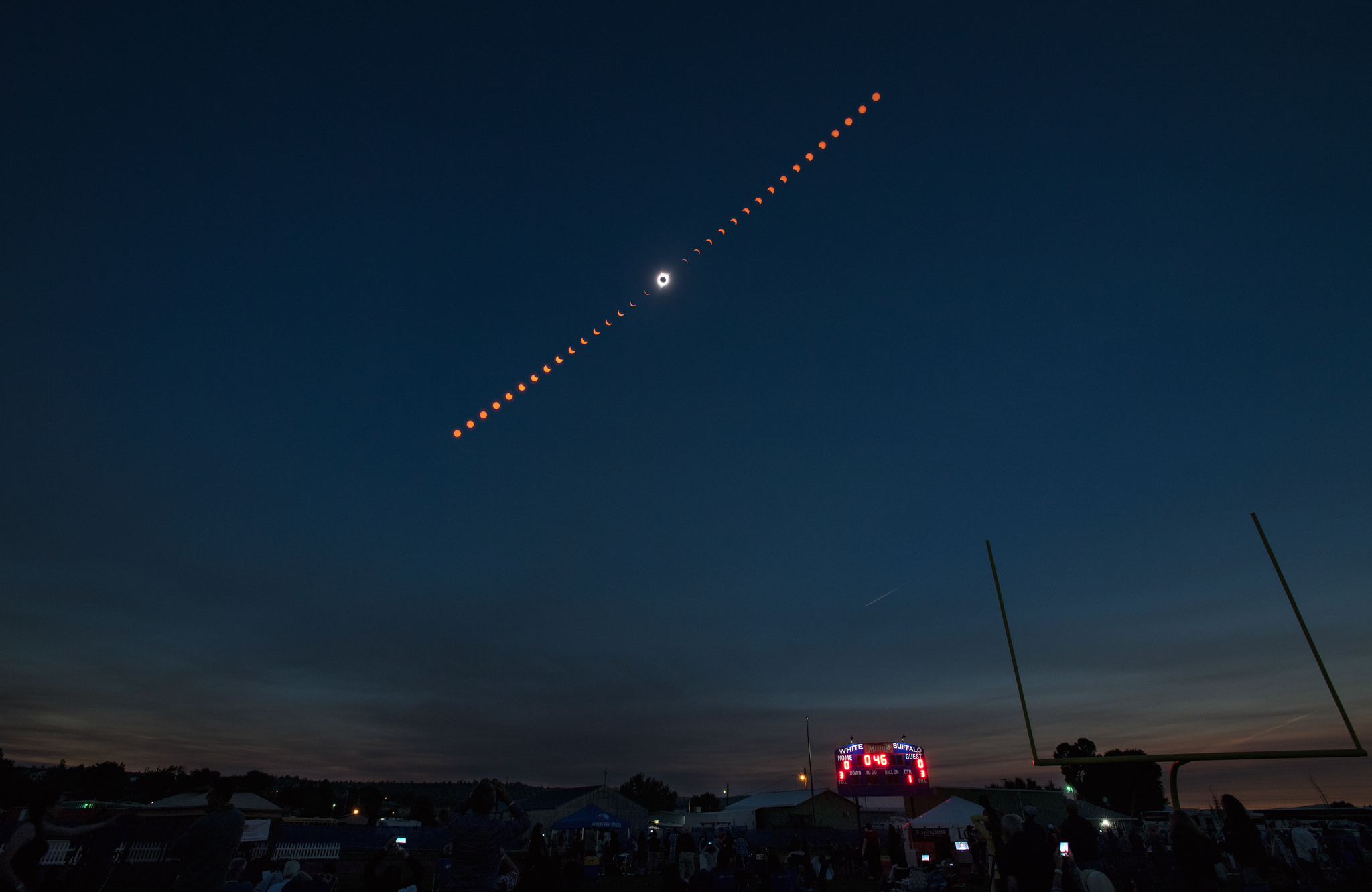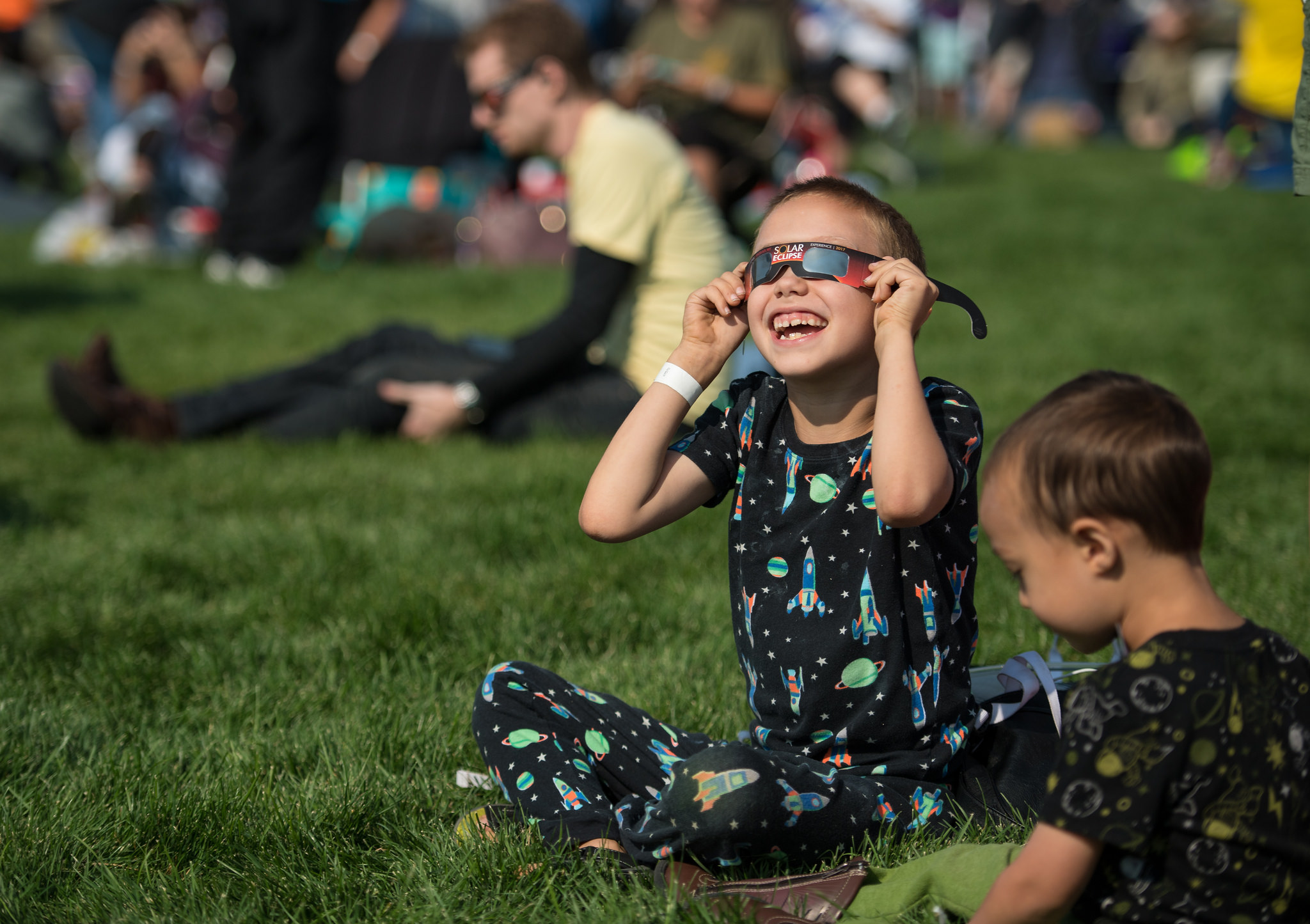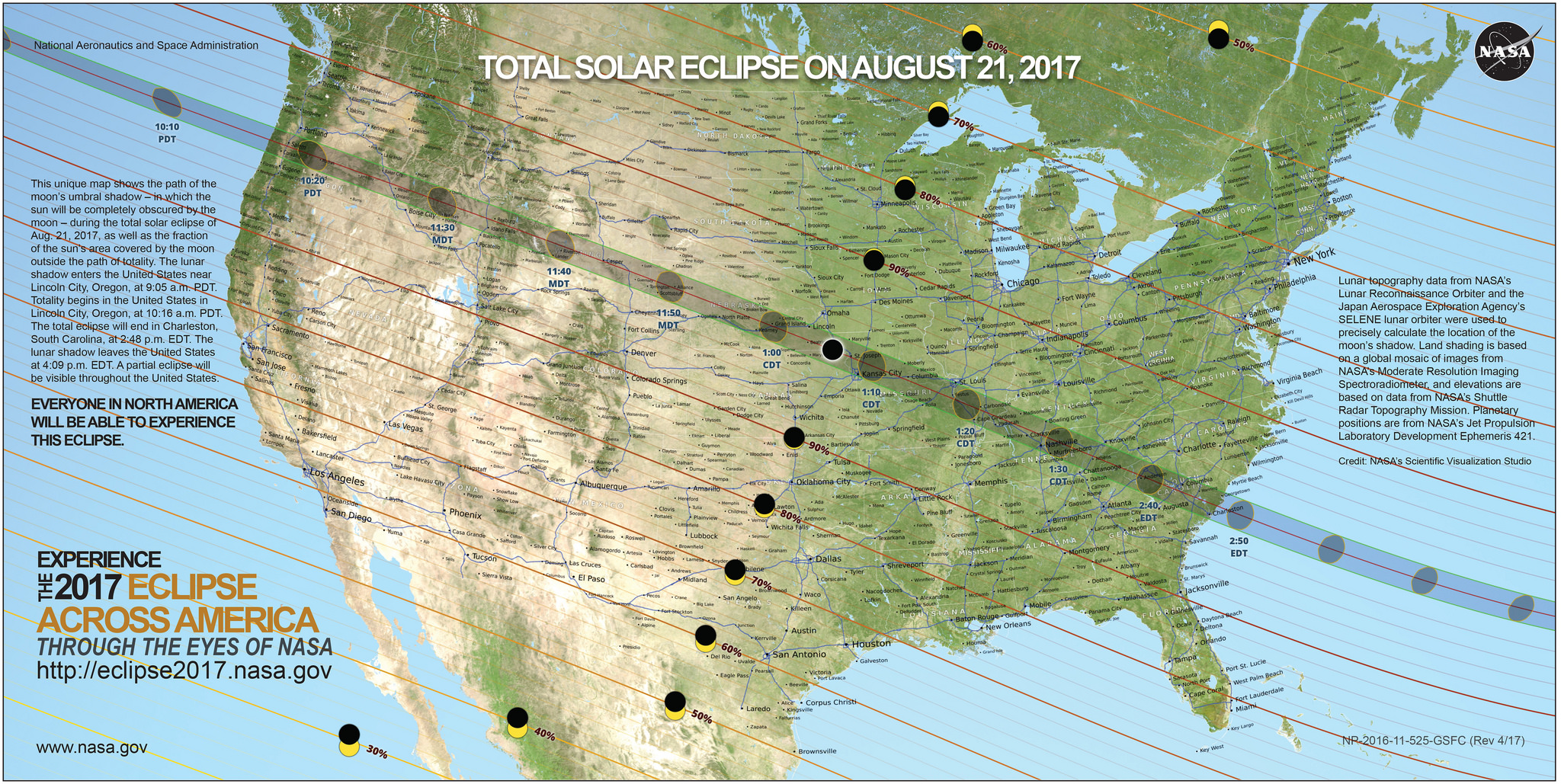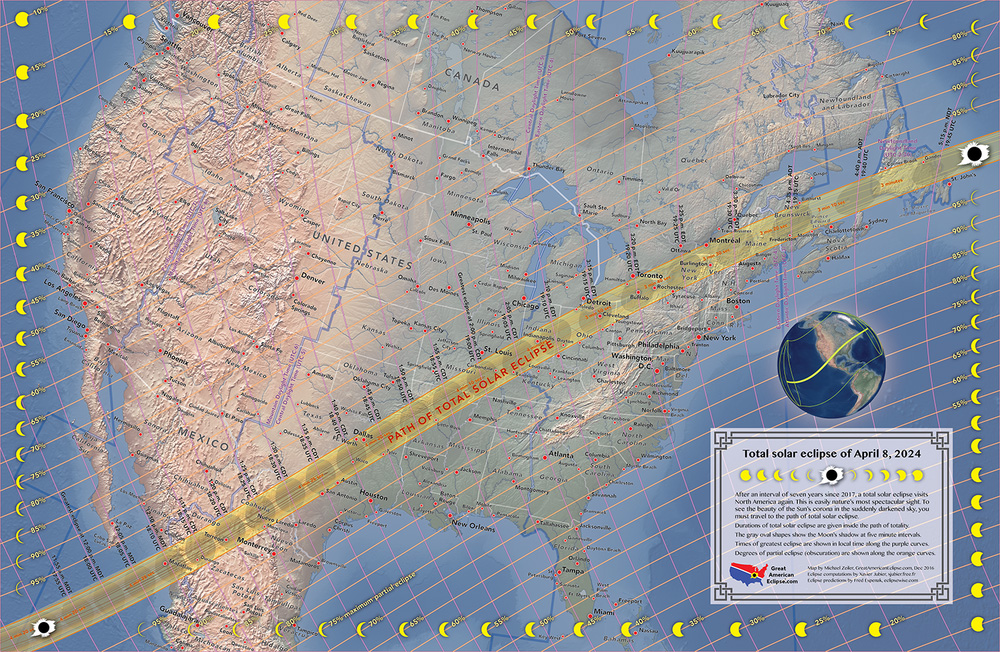Skywatching Event of the Year: How a Solar Eclipse Captivated America in 2017
Though 2017 included several astronomical highlights, the Great American Solar Eclipse of Aug. 21 stands out as the biggest skywatching event of the year, if not all time.
While a partial solar eclipse was visible in most of the United States, a total solar eclipse could be seen in a smaller, coast-to-coast path stretching from Oregon to South Carolina. An estimated 215 million American adults — 88 percent of the U.S. adult population — turned their eyes to the skies to witness the historic event. That's nearly twice the viewership of this year's Super Bowl, according to one study.
"It was an epic event by all measures," NASA solar researcher Lika Guhathakurta told members of the press this month at the American Geophysical Union conference in New Orleans. The eclipse broke NASA's previous web-traffic records about seven times over, with the agency's eclipse websites receiving more than 90 million page views on Aug. 21. [Amazing Photos: Relive the 2017 Total Solar Eclipse]
"The NASA solar eclipse coverage was the agency's most watched and most followed event on social media to date," Guhathakurta said.

"One of the biggies"
A solar eclipse occurs when the moon passes between Earth and the sun. In a partial eclipse, the moon only "takes a bite" out of the sun. Because the sun isn't fully blocked during a partial solar eclipse, viewers must wear safety glasses throughout the event. But during a total solar eclipse, the moon completely blocks the body of the sun, making it safe to remove protective glasses to observe the usually hidden structures of the solar atmosphere. [Photos: Coolest 2017 Solar Eclipse Signs and Celebrations]
NASA estimates that more than 200 million U.S. adults observed the eclipse, but it's not quite clear how many children might have viewed it because kids couldn't be surveyed, Jim Green, director of NASA's Planetary Science Division, told Space.com. But those uncounted kids might have gotten the most out of the eclipse.

"To me, this is probably one of the greatest events, providing to our kids an exciting opportunity to witness a natural phenomenon that they may want to know more about," Green said. Experiencing the eclipse may make them curious about the sun, the moon, the climate or other things that could spur an interest in science.
Get the Space.com Newsletter
Breaking space news, the latest updates on rocket launches, skywatching events and more!
"It is an experience that they will take with them," Green said.
Related: The Greatest Skywatching Moments of 2017
But just because the eclipse is over, that doesn't mean children — or adults — need to stop being interested in the sun or throw out their eclipse glasses. Green pointed out that eclipse glasses can be used to study the sun, which occasionally has sunspots large enough to be viewed using only solar eclipse glasses.
In fact, the eclipse could serve as a "gravity assist" for getting young people into scientific fields, Green added. Much as a moon or planet can change a spacecraft's path and send it speeding in a new direction, an event such as the eclipse can pique children's interest and set them on a path to explore science and math.
"This was one of the biggies," Green said.
Elevate their experience
A total solar eclipse occurs somewhere on Earth about once every 18 months, but most of those events occur over water, making it challenging for most people to observe them. Others occur in remote regions or countries where communication and transportation can be difficult. [The Most Amazing 2017 Total Solar Eclipse Photos From Space]
That's one of the reasons the total solar eclipse of 2017 was so special, Guhathakurta said.
"This eclipse, in particular, offered the scientists a really unique opportunity, as it fell upon our first world nation with a sophisticated infrastructure, a developed nation excited by the notion of citizen science," Guhathakurta said. The last solar eclipse to cross the United States occurred nearly a hundred years ago.

According to Kristen Erickson, NASA's science engagement and partnerships director, the agency's objective in 2017 was to increase scientific literacy and scientific education. [Photos: Great American Solar Eclipse Seen from a Plane]
"We suspected that the 2017 total solar eclipse was going to be a pretty big deal," Erickson told Space.com.
"Then, we said, 'How can we make this the most enriching experience for the most citizens across the country?'"
NASA recruited partners from various companies, libraries and volunteer networks, and worked to organize them all, she said.
"We had a lot of these things in place," Erickson said. "It was really just a matter of taking a leadership vision of what could happen."
During the eclipse, NASA supported 11 scientific investigations and many more citizen-science investigations, Guhathakurta said.
One such investigation was the Citizen Continental-America Telescopic Eclipse (Citizen CATE) experiment, which put telescopes into the hands of teams at 68 sites to have them study the structure of the sun. Matt Penn, who led Citizen CATE, said most of their volunteers had already planned to watch the eclipse.
"What we did was try to enable them to elevate their experience," Penn said.
Angela Des Jardins is the principal investigator on the Eclipse Ballooning Project, which helped nearly a thousand students on 55 high school and college teams fly science balloons into the upper atmosphere during the eclipse.
Des Jardins said one of the key lessons she learned that will help her prepare for the next eclipse was that engaging nonscientists goes beyond developing accessible science projects.
"You have to do something that's really exciting and challenging to get the students involved and to get the general public involved," she said.
Ready for 2024

The sun has set on the 2017 eclipse, but NASA is already gearing up for the next one. In 2024, a total solar eclipse will sweep across the eastern United States, on its way from Mexico to Canada. [Total Solar Eclipse of 2024: Maps of the 'Path of Totality']
As for whether NASA plans to coordinate events for the upcoming solar event, "there's no question, to me anyway, if I'm still the director of [NASA's] Planetary Science [Division] in 2024," Green said.
The 2017 eclipse also offered learning experiences to keep in mind for the next solar event. For example, there was the last-minute eclipse-glasses scare that popped up in the days leading up to the eclipse. When NASA realized that many unsafe eclipse glasses were on the market, the agency hurried to let people know how to tell if their glasses were safe for eclipse viewing.
Erickson cited Rick Fienberg, press officer for the American Astronomical Society (AAS), as the "unsung hero." The AAS had a website listing the names of reputable vendors of filters and glasses, and detailing how to view the eclipse safely.
"NASA relied on AAS and his [Fienberg's] leadership for the whole safe solar viewing," Erickson said.
The agency will learn from that experience to be better prepared to teach safe viewing for the 2024 eclipse, she said, adding that glasses from this year's eclipse will still be usable in 2024.
Citizen science will continue for the next eclipse as well. Penn said Citizen CATE received more attention than they had anticipated.
"We could have had 200 sites, easily, with the amount of interest," Penn said. "I think we could have a much bigger event in 2024."
Follow Nola Taylor Redd at @NolaTRedd, Facebook, or Google+. Follow us at @Spacedotcom, Facebook or Google+. Originally published on Space.com.
Join our Space Forums to keep talking space on the latest missions, night sky and more! And if you have a news tip, correction or comment, let us know at: community@space.com.

Nola Taylor Tillman is a contributing writer for Space.com. She loves all things space and astronomy-related, and enjoys the opportunity to learn more. She has a Bachelor’s degree in English and Astrophysics from Agnes Scott college and served as an intern at Sky & Telescope magazine. In her free time, she homeschools her four children. Follow her on Twitter at @NolaTRedd









